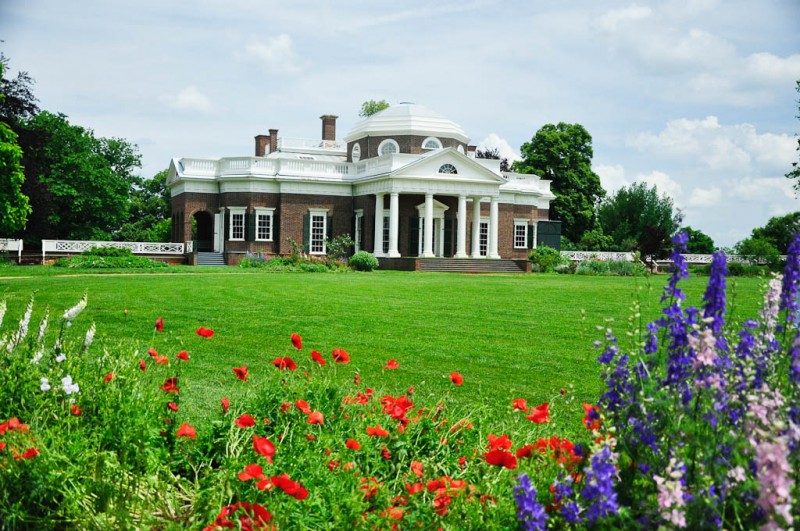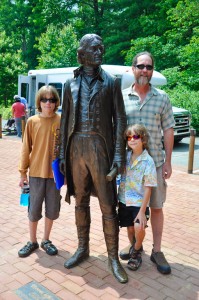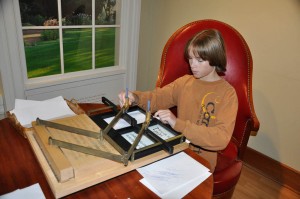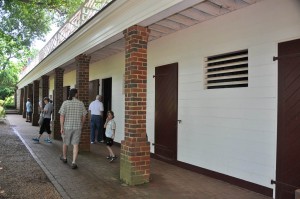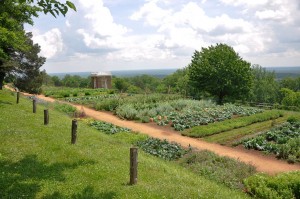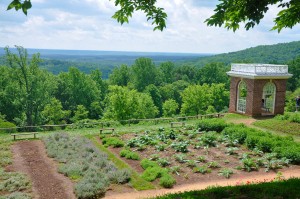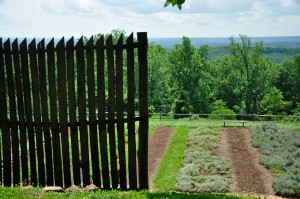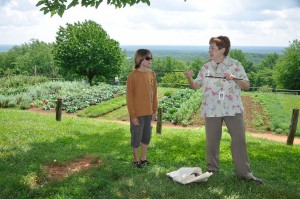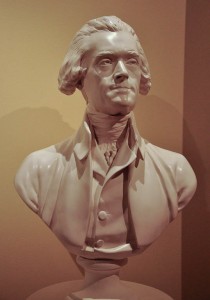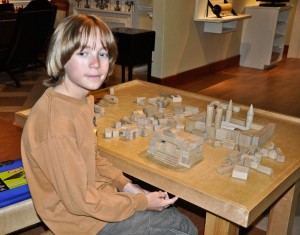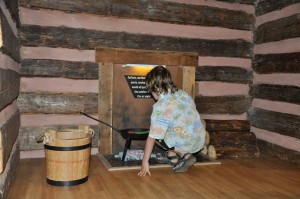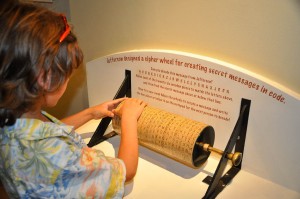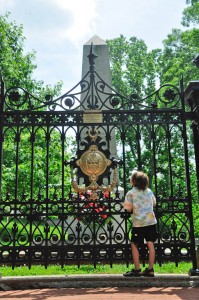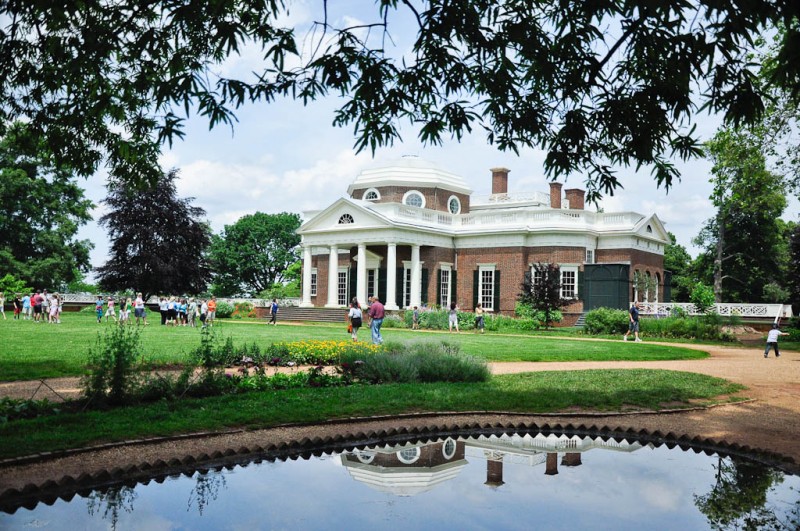Monticello, Italian for “little mountain” is Thomas Jefferson’s estate in Charlottesville, Virginia. As we move into the Northeast part of the country, we will be encountering the historic areas that saw the birth of the country and Monticello was the first of these areas that we have encountered. It was also Jefferson’s sanctuary, a place he found solace and a place he could carry out his passion for botanical research.
I had been to Monticello in high school and my most prominent memory of the visit was that he was a gadget guy, an 18th century techy. He was also an architect and found ways to work gadgets into the design of his home. Like the rooftop wind vane that attaches to a directional arm on his front porch so he could tell the wind direction without going outside, an automatic door opener and a clock that also registers the day with a system of pulleys and weights.
left and below: The Dudes check out a polygraph machine Jefferson used to make copies of his writings.
Jefferson also spoke seven languages, was the principle author of the Declaration of Independence, was the founder of the University of Virginia, was the 3rd President of the United States, doubled the size of the country with the Louisiana Purchase and oh, in his spare time, he recorded daily details of the weather ….. faithfully for 50 years. And that is just a sampling of his accomplishments. Reading about him and all he did including helping to create a country makes me feel like a real slouch.
He spent 40 years designing and building Monticello on the 5,000 acre estate left to him by his father. When he died, he was severely in debt and his daughter had to sell the property and all of his belongings to cover the debt. Fortunately, the property eventually landed in the hands of an admiring friend which enabled the property to be saved as a national landmark. Many of his possessions have been recovered and it has been restored to it’s former glory. We were able to tour the first floor (no photos allowed) and the dependencies in the basement of the 4 story structure.
left: Touring the “dependencies” on the lower level.
right: The kitchen.
The house sits at 850 ft. with beautiful views of the surrounding countryside. Some of the furnishings in the home are reproductions of items taken from Jeffersons notes as he kept meticulous notes of every item in the house as well as its location. In fact he kept meticulous notes of everything.
left and below: part of his garden and view from the “top”.
The 1000 ft. garden is planted in accordance with his notes and as many as 300 different plants could be found in his garden. I can’t even balance my checkbook and this guy manages to find time to start a revolution and record what the best temperature and soil moisture is needed to grow peas.
We also toured Mulberry Row on a hill just below the house where Jefferson’s slaves lived and worked. A fascinating part of his story is that he was totally against the idea of slavery but being born into the culture at a time when society wasn’t ready for change left him owning over 600 slaves in his lifetime.
above: The tour guide volunteers the Big Dude for a demonstration on how ten year old slaves made nails in the nailery.
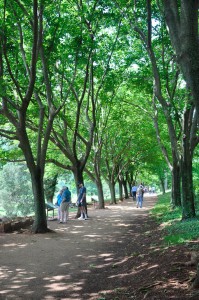 above: Tree lined Mulberry Row.
above: Tree lined Mulberry Row.
An abbreviated timeline of Jefferson’s role in slavery and equality and subsequent history.
1776 – The Constitution – We hold these truths to be self evident, that all men are created equal, that they are endowed by their Creator with certain unalienable rights, that among these are Life, Liberty and the Pursuit of Happiness.
1807 – As President, signed the Act prohibiting the Importation of Slaves.
1820 – “ during the political crisis that resulted in the Missouri Compromise, Jefferson had come to believe that the spread of slavery into the west &—its “diffusion”&—would prove beneficial to the slaves and hasten the end of the institution. The prospect of a geographical line based on principle running across the country, “like a fire bell in the night, awakened and filled me with terror.” He feared it could threaten the union and lead to civil war.
1826 – “The revolution in public opinion which this cause requires, is not to be expected in a day, or perhaps in an age; but time, which outlives all things, will outlive this evil also. My sentiments have been forty years before the public. Had I repeated them forty times, they would only have become the more stale and threadbare. Although I shall not live to see them consummated, they will not die with me”
1826 – Jefferson’s death.
1861 – First shots of the Civil War.
1863 – Abraham Lincoln reads the Emancipation Proclamation.
1865 – The Thirteenth Amendment to the Constitution officially outlaws slavery.
1963 – Martin Luther King delivers his “I Have a Dream” speech.
Jefferson, a visionary, appeared to understand the complexities of the slavery issue and equality and despite his view on the subject he also understood that it was an issue to be resolved by another generation.
left: A bust of Jefferson in the Discovery Center which is a room designed as a hands on experience for kids. The Dudes loved it.
right: The Big Dude makes a “rubbing” of Jefferson’s grave stone.
left: The Big Dude creates his own “Monticello”.
right: The Lil’ Dude “cooks up supper” in a slave cabin.
left: The Lil’ Dude tries to decipher a message on Jefferson’s “cipher”
right: Jefferson’s grave.
As we toured his house and garden I tried to imagine what life would have been like living there in the 1700’s. I couldn’t. Although, looking out over the rolling hills, I could completely understand why Jefferson came here to get away from it all.
“I am as happy no where else and in no other society, and all my wishes end, where I hope my days will end, at Monticello. Too many scenes of happiness mingle themselves with all the recollections of my native woods and feilds, to suffer them to be supplanted in my affection by any other.” Thomas Jefferson


